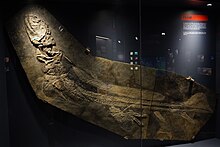Lebachacanthus
| Lebachacanthus Temporal range: Early Permian PreꞒ Ꞓ O S D C P T J K Pg N | |
|---|---|
 | |
| Specimen in Urzeitmeer-Museum | |
| Scientific classification | |
| Domain: | Eukaryota |
| Kingdom: | Animalia |
| Phylum: | Chordata |
| Class: | Chondrichthyes |
| Subclass: | Elasmobranchii |
| Order: | †Xenacanthida |
| Family: | †Diplodoselachidae Soler-Gijon, 1997 |
| Genus: | †Lebachacanthus Soler-Gijon, 1997 |
| Type species | |
| Lebachacanthus senckenbergianus (Fritsch, 1889) | |
| Other species | |
| |
| Synonyms | |
| |
Lebachacanthus is a genus of extinct xenacanth cartilaginous fish known from the late Carboniferous-Early Permian of Europe.[1] Well-preserved specimens, originally identified as Orthacanthus, are known from Meisenheim Formation in Germany.[2] During the late Paleozoic, xenacanths were the apex predators of freshwater ecosystems, preying on small amphibians.[3]
Description

Like most other xenacanthids, this genus possessed an array of spines arising from the dorsal fins.[4] It exceeded 3 metres (9.8 ft) and even could reach 3.5 metres (11 ft).[4][5] The genus is often confused with the similar genus Orthacanthus; the two genera belong to entirely separate families.[6] The teeth of this fish were multi-cusped, with the central cusp flanked by two sharp accessory "tines" on which its prey would be impaled and trapped, in preparation for being swallowed whole.[7] It had an abundance of pectoral fins, two next to the head, two in the middle, one near the end, and one under the caudal fin.
Paleobiology
Lebachacanthus patrolled both fresh and marine waters, possibly preying on larvae of the temnospondyli and acanthodians.[3] The genus displays sexually dimorphic features; females had longer fin spines than males. Histological and biometric analyses of the spines of specimens provides information on the development and age at death of the fish and the environmental conditions in which they lived.[4]
References
- ^ Ivanov, Alexander (30 August 2005). "Early Permian chondrichthyans of the Middle and South Urals". Revista Brasileira de Paleontologia. 8 (2): 127–138. doi:10.4072/rbp.2005.2.05. ISSN 1519-7530.
- ^ Luccisano, Vincent; Pradel, Alan; Amiot, Romain; Pouillon, Jean‐Marc; Kindlimann, René; Steyer, Jean‐Sébastien; Cuny, Gilles (2022). Cavin, Lionel (ed.). "Systematics, ontogeny and palaeobiogeography of the genus Orthacanthus (Diplodoselachidae, Xenacanthiformes) from the lower Permian of France". Papers in Palaeontology. 8 (6). doi:10.1002/spp2.1470. ISSN 2056-2799.
- ^ a b Kriwet, J.; Witzmann, F.; Klug, S.; Heidtke, U. H. (2007). "First direct evidence of a vertebrate three-level trophic chain in the fossil record". Proceedings. Biological Sciences. 275 (1631): 181–186. doi:10.1098/rspb.2007.1170. PMC 2596183. PMID 17971323.
- ^ a b c Beck, Kimberly; Soler-Gijon, Rodrigo; Carlucci, Jesse; Willis, Raymond (2014). "Morphology and histology of dorsal spines of the xenacanthid shark Orthacanthus platypternus from the Lower Permian of Texas, USA: Palaeobiological and palaeoenvironmental implications" (PDF). Acta Palaeontologica Polonica. doi:10.4202/app.00126.2014. S2CID 53979047.
- ^ Soler-Gijón, R. (2004). "Development and growth in xenacanth sharks: new data from Upper Carboniferous of Bohemia". G. Arratia, M.V.H. Wilson, and R. Cloutier (eds.), Recent Advances in the Origin and Early Radiation of Vertebrates: 533–562.
- ^ Soler-Gijón, Rodrigo (December 2000). "Phylogenetic relationships of Lebachacanthidae [Soler-Gijón 1997] (Xenacanthiformes; Elasmobranchii)". PalZ. 74 (3): 363–377. doi:10.1007/BF02988107.
- ^ Hotton, Nicholas (1952). "Jaws and Teeth of American Xenacanth Sharks". Journal of Paleontology. 26 (3): 489–500. JSTOR 1299956.
Further reading
- Long, John A.; Young, Gavin C. (May 1995). "Sharks from the Middle-Late Devonian Aztec Siltstone, southern Victoria Land, Antarctica" (PDF). Records of the Western Australian Museum. 17: 287–308. Retrieved 10 March 2022.
- v
- t
- e
| |||||||
|---|---|---|---|---|---|---|---|
| |||||||
| ||||||||||||||||||||||||||||||||||||||||||||||
"Conventionally defined chondrichthyans" | ||||||||||||||||||||||||||||||||||||||||||||||||||||||
|---|---|---|---|---|---|---|---|---|---|---|---|---|---|---|---|---|---|---|---|---|---|---|---|---|---|---|---|---|---|---|---|---|---|---|---|---|---|---|---|---|---|---|---|---|---|---|---|---|---|---|---|---|---|---|
| 
 | |||||||||||||||||||||||||||||||||||||||||||||||||||||
Incertae sedis scale-based taxa | |||||||||||||||||||||||
|---|---|---|---|---|---|---|---|---|---|---|---|---|---|---|---|---|---|---|---|---|---|---|---|
| |||||||||||||||||||||||
 Category
Category
 | This article about a prehistoric cartilaginous fish is a stub. You can help Wikipedia by expanding it. |
- v
- t
- e


















